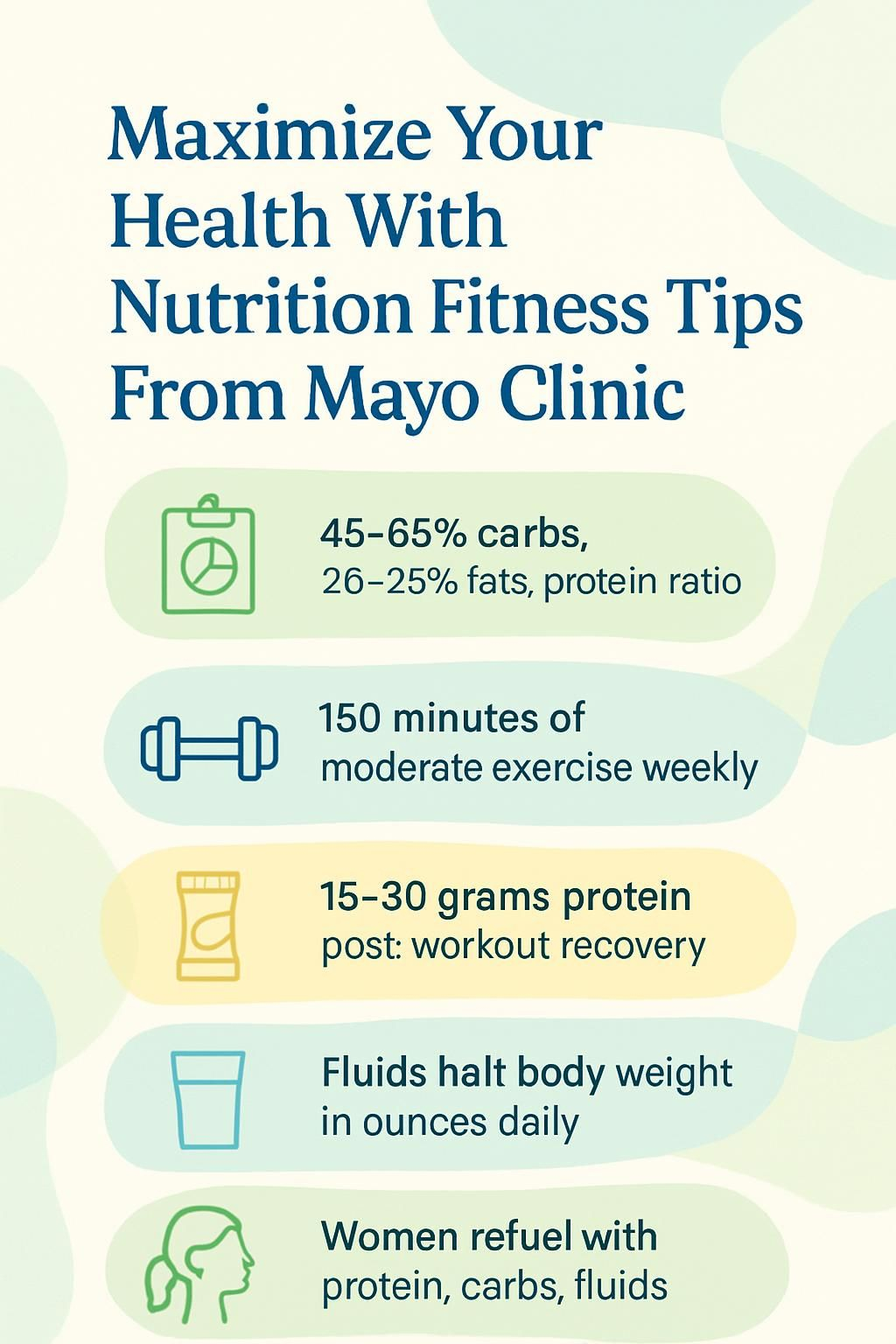Maximize Your Health With Nutrition Fitness Tips From Mayo Clinic
Our Nutrition Assistant AI Suite will transform your body. You will lose fat, get toned, and build muscle. Gain confidence and optimal health.
You want better energy, faster recovery, and steady progress. The link between nutrition and fitness is the missing piece for many people. When you eat right, every workout feels more productive and your body bounces back quicker.
This article shares practical nutrition tips from Mayo Clinic and other trusted sources. You will learn how to fuel before and after exercise, hydrate well, and plan meals that support your routine. Small changes today can keep you strong and energized all week.
Key Takeaways
- Mayo Clinic suggests a balanced diet for fitness: 45–65% carbohydrates, about 0.6–0.9 grams of protein per pound of body weight per day, and 20–35% healthy fats.
- For heart health, adults should get at least 150 minutes of moderate activity each week, as advised by the Centers for Disease Control and Prevention.
- Eat 15–30 grams of protein with carbohydrates within 30–45 minutes after exercise to speed muscle repair and refill energy stores.
- A simple hydration guide is half your body weight in ounces of fluid daily. Aim for light yellow urine and consider electrolytes for long or hot workouts.
- Many women recover better when they refuel within 45 minutes post-workout with carbs, protein, and fluids, a point Mayo Clinic experts emphasize.

Why Are Nutrition and Fitness Important for Overall Health?

Good nutrition and regular exercise give your body the nutrients and energy it needs for strong bones, a healthy heart, and clear thinking. The U.S. Department of Health and Human Services notes that healthy eating can lower your risk of chronic diseases such as type 2 diabetes, heart disease, and some cancers.
People who follow the Dietary Guidelines for Americans are less likely to develop these conditions with age. A simple goal from MyPlate.gov is to fill half your plate with fruits and vegetables. That habit increases vitamins, dietary fiber, antioxidants, and minerals.
Sticking to an exercise routine supports a healthy weight and improves mood and sleep. The Centers for Disease Control and Prevention recommends at least 150 minutes of moderate activity each week, such as brisk walking or cycling.
Small changes matter. Swapping white bread and sugary snacks for whole grains before practice can boost energy and focus for your workout.
“Strong muscles are built in the kitchen as much as in the gym,” says Mayo Clinic dietitian Katherine Zeratsky, RD, LD.
Resources like Nutrition.gov offer simple hydration and fueling tips you can use today. Your future health grows with every balanced meal and every workout you complete.
Essential Nutrition Tips to Improve Your Workouts
You can improve fitness results with a few smart changes to your plate. Mayo Clinic guidance shows how food choices affect energy, strength gains, and recovery after exercise.
What Should a Balanced Diet Include for Fitness?
A balanced diet for fitness includes three macronutrients: carbohydrates, protein, and healthy fats. Carbohydrates should provide about 45–65% of your daily calories because they power your muscles and support your immune system.
Choose nutrient-dense carbs such as whole grains, fruits, vegetables, and legumes.
Protein should total about 0.6–0.9 grams per pound of body weight each day. For a 150‑pound person, that is roughly 90–135 grams. Spread it across meals and snacks from lean meats, eggs, dairy like milk or yogurt, beans, tofu, and fish such as salmon to support muscle repair.
Healthy fats should make up 20–35% of calories. Good sources include avocados, olive oil, canola oil, nuts, seeds, and fatty fish. These fats support heart, joint, and brain health.
Dialing in these basics sets the stage for better pre-workout fueling.
How Can Pre-Workout Snacks Boost Performance?
A pre-workout snack raises blood sugar, which supplies fast energy for your muscles. Pick easy-to-digest carbohydrates such as a banana, grapes, or half a cup of dry oatmeal with nuts and fruit if you have more than an hour before exercise.
A banana with one tablespoon of peanut butter about an hour before training provides carbs and a little protein for steady energy. If you have only 5–15 minutes, raisins or a tablespoon of honey can give a quick glucose boost for aerobics or strength work.
Hydration matters too. Water with electrolytes helps you avoid dehydration, supports a steady heart rate, and keeps muscles firing well.
Snacking with purpose helps you perform better and protects hard-earned muscle.
What Are the Best Post-Workout Meals for Energy?
Refuel within 30 minutes to 2 hours after exercise. Waiting longer can limit how well your body restocks nutrients. Aim for 15–30 grams of protein with enough carbohydrates to replace lost glycogen, the stored form of glucose in muscle.
Simple options work well: a veggie egg bake with whole-wheat toast, a protein smoothie with fruit, or a chicken and hummus wrap with a side of cherries. These meals digest smoothly, restore energy, and prepare you for your next session. Mayo Clinic Health System guidance supports this recovery window.
How Much Water Should You Drink Around Exercise?
You lose fluids through sweat, so drink before, during, and after activity. A daily baseline is half your body weight in ounces of fluid. If you weigh 150 pounds, target at least 75 ounces across the day, then add more around workouts or in hot weather.
Check hydration by aiming for light yellow urine and staying ahead of thirst. Hydration can include plain water, seltzer, sports drinks if you sweat heavily, milk, and water-rich produce. Good fluid habits protect heart health and support athletic performance.
Why Include Micronutrients and Antioxidants in Your Diet?
Iron and vitamin D matter for strength, bone health, and immunity. Low iron can cause fatigue with exercise. Vitamin D helps your body absorb calcium, which keeps bones strong. Omega‑3 fats from walnuts and fatty fish support muscle repair and may lower exercise-induced inflammation.
Colorful fruits and vegetables deliver antioxidant phytochemicals that protect cells from free radicals produced during intense training. Think spinach, berries, and peppers. Focus on nutrient-dense foods, not added sugar or highly processed snacks, to improve fitness and manage blood glucose.
Next, see how each macronutrient drives performance.
Understanding Macronutrients and Their Fitness Benefits
Macronutrients fuel your training and shape progress. Knowing how carbs, protein, and fats work helps you build strength, manage weight, and recover faster.
How Do Carbohydrates Provide Energy?
Carbohydrates are your main energy source for daily tasks and exercise. Digestion breaks them into glucose, which travels in your blood to fuel working muscles with help from insulin, a hormone made by the pancreas.
Carbs support high‑intensity efforts like sprints and steady endurance like cycling. Your muscles store some carbs as glycogen for quick power. Whole grains, fruits, and vegetables also aid digestion and support your gut microbiome, which helps immunity.
Why Is Protein Important for Muscle Repair and Growth?
Carbs supply quick energy, but protein repairs muscle tissue stressed by training. Protein is made of amino acids, which patch tiny muscle tears and build new fibers. Low protein slows progress and can extend soreness.
Enough protein also supports hormones and your immune system. Include lean meats, dairy, beans, lentils, and seeds in your meals. For example, Greek yogurt or a handful of almonds after lifting can speed recovery.
Adults need about 0.8 grams of protein per kilogram of body weight daily. Many athletes need more for best results. Choose quality sources over highly processed options that are high in sodium or saturated fat.
Eating enough protein can raise your basal metabolic rate, meaning you burn slightly more calories at rest.
[1] Source: Centers for Disease Control and Prevention (CDC).
What Are Healthy Fats and Their Role in Energy?
Healthy fats, such as monounsaturated and polyunsaturated fats, provide steady energy during rest and low‑intensity exercise. Foods like avocado, nuts, olive oil, and other vegetable oils support heart health by improving your cholesterol profile. They raise HDL, the helpful cholesterol, and can lower LDL.
Avoid trans fats in processed foods, since they raise LDL and harm cardiovascular health. Replacing common cooking oil with extra virgin olive oil can support heart function without increasing body weight. Fatty fish like salmon can also sharpen mental focus.
Healthy fats support hormone production, joint comfort, and mood. That makes them important for long-term weight management and training.
Pre-Workout Nutrition Strategies
Eating and exercise work best as a team, so time your fuel wisely for stronger workouts.
When Is the Best Time to Eat Before Working Out?
Eat a snack with complex carbohydrates and some protein about one hour or more before exercise. This timing gives your digestive system a head start and reduces hunger while you train.
If you have 30–60 minutes, choose simple carbs plus a little protein. In a rush, pick a quick, easy snack 5–15 minutes before you start. Mayo Clinic experts explain that timing changes how your body uses the food you eat.
Many people find a slice of whole‑grain toast with peanut butter about an hour before activity gives steady, comfortable energy.
What Are Examples of Effective Pre-Workout Snacks?
Match your snack to your timing and sweat rate. Mayo Clinic’s approach is simple and practical.
- Eat 1/2 cup dry oatmeal with nuts and fruit at least 1 hour before training for steady energy and fiber.
- Have a banana with 1 tablespoon peanut butter up to 1 hour beforehand for quick carbs, potassium, and some healthy fat.
- Enjoy energy bites made with oats, nut butter, honey, or dried fruit about an hour in advance for a balanced mix.
- Snack on raisins 5–15 minutes before activity for a fast rise in blood sugar.
- Take 1 tablespoon honey right before exercise for immediate carbohydrate energy.
- Drink an electrolyte beverage 10 minutes pre‑workout if you expect heavy sweating to help balance fluids and sodium.
- For cardio days, oatmeal with berries can keep blood sugar steady and reduce mid‑workout hunger.
Use these options as a menu, then adjust portions to your needs.
Post-Workout Nutrition Strategies
What you eat after training can speed muscle repair and refill your tank for next time.
Why Is Protein Intake Crucial After Exercise?
Your muscles rebuild after you exercise, so protein soon after a workout is key. Aim for at least 20 grams within 45 minutes for best recovery. Many women notice less soreness and better energy when they meet this window.
Protein gives your body the materials to repair muscle and support a healthy body composition. Mayo Clinic experts suggest pairing protein with complex carbs for better results.
What Are the Best Carbohydrate-Protein Combinations for Recovery?
Carbohydrates plus protein refuel glycogen and repair tissue efficiently. Mayo Clinic recommends 15–30 grams of protein with enough carbs to restore energy.
- Greek yogurt with granola or fruit provides about 20 grams of protein and up to 40 grams of carbs.
- A turkey or chicken sandwich on whole‑grain bread combines lean protein with complex carbs.
- Low‑fat chocolate milk offers quick sugars and 8–12 grams of protein per cup.
- A whey protein smoothie with bananas or berries delivers fast absorption.
- Salmon with brown rice gives healthy fats and slow‑releasing carbs for a full meal.
- Steak pieces with roasted sweet potatoes supply at least 25 grams of protein and fiber.
- Ready‑to‑drink shakes can fit the protein‑carb range when you need convenience.
A cold carton of chocolate milk can be a simple, effective choice after a run when you want something quick.
How Should You Stay Hydrated During Fitness Activities?
Hydration keeps your heart, brain, and muscles working smoothly, especially as training heats up.
How Can You Monitor Water Intake During Workouts?
Start with a daily target: divide your weight in pounds by two to get your ounces of fluid. If you weigh 160 pounds, that is at least 80 ounces, then add more during hot days or long workouts.
Check for thirst and urine color. Pale yellow usually signals good balance, while darker shades can mean dehydration. A water bottle with ounce markings helps you stay consistent at the gym or on the go.
Hydration works hand in hand with sodium intake. Managing salt and water together supports blood pressure and performance.
What Are the Benefits of Electrolyte Drinks?
During long, intense, or hot workouts, water alone may not replace minerals lost in sweat. Electrolyte drinks provide sodium, potassium, calcium, and magnesium. These minerals support nerve signals and muscle contraction, which can help prevent cramps and dizziness.
Some research shows athletes who sip electrolyte drinks during heavy training have fewer dehydration symptoms than those who use water only. If your sessions run past an hour, adding electrolytes may protect energy and recovery. A few options include sports drinks, electrolyte powders, or tablets.
How Do Micronutrients Affect Fitness and Performance?
Vitamins and minerals support energy use, muscle function, and recovery under training stress. Think of them as the small tools that make big systems work.
Which Vitamins and Minerals Support Exercise?
Focus on a few priorities to support workouts and overall health.
- Iron delivers oxygen to your muscles. It is often low in women and high‑intensity athletes. Combine lean meats, beans, or spinach with vitamin C foods to boost absorption.
- Vitamin D supports bones, immunity, and muscle function. Get safe sunlight when possible and include fortified dairy or fish.
- Calcium builds strong bones and supports muscle contraction. Choose low‑fat dairy or leafy greens.
- Magnesium helps muscles relax and supports a steady heart rhythm. Nuts, seeds, and whole grains are good sources.
- Potassium helps manage fluid balance and can reduce cramping. Bananas, potatoes, and yogurt fit well after training.
- Sodium helps maintain hydration in heavy sweaters. Use electrolyte drinks for endurance days and limit processed high‑sodium foods.
- Vitamin C supports immunity and helps iron absorption. Citrus and peppers are simple options.
- Zinc supports cell repair and immune function. Add seafood, beans, or pumpkin seeds.
- B vitamins help turn carbohydrates, fats, and protein into energy. Choose whole grains and lean proteins.
Together, these nutrients support training, reduce fatigue, and protect your body from avoidable setbacks.
What Are Phytochemicals and Functional Ingredients?
Phytochemicals are natural compounds in plant foods like fruits, vegetables, nuts, seeds, and whole grains. Many act as antioxidants that help reduce exercise-related inflammation and protect cells from damage.
Functional ingredients offer extra benefits beyond basic nutrition. Omega‑3 fats from walnuts and fatty fish support heart health and recovery. Caffeine can enhance alertness and strength if taken about an hour before training. Creatine can boost short, powerful efforts. Collagen may support joint comfort when combined with balanced meals.
Adding fish twice a week or a small collagen serving in a smoothie can ease joint stiffness for some people.
What Are Women’s Unique Nutrition and Fitness Needs?
Women face unique fueling and recovery needs across the lifespan. Strategic timing and smart food choices can make training feel more consistent.
How Does Nutrition Affect Women’s Post-Exercise Recovery?
After training, female physiology may benefit from faster refueling. Mayo Clinic experts encourage a mix of carbohydrates, protein, and fluids within 30–45 minutes to support energy and muscle repair.
Skipping this window can lead to fatigue, longer soreness, or slower progress during future sessions. A simple snack like Greek yogurt with fruit or a peanut butter sandwich on whole‑grain bread often helps you feel stronger for your next workout.
What Hormonal Factors Influence Female Fitness?
During the second half of the menstrual cycle, progesterone rises and can increase muscle breakdown. Recovery may feel slower, especially for perimenopausal or postmenopausal women.
Carbohydrate cravings often increase in the luteal phase. Meeting those needs with nutrient‑dense carbs, such as fruit and whole grains, can stabilize energy and support training.
How Can Plant-Based Diets Benefit Your Fitness?
Plant‑forward eating can lower inflammation and provide steady energy for training and recovery.
How Do Plant-Based Foods Help Reduce Inflammation?
Colorful plant foods deliver antioxidants that help neutralize free radicals created during hard workouts. Berries, leafy greens, and peppers are rich in these helpful compounds. Some studies link anthocyanins in berries to less muscle soreness.
Mayo Clinic guidance supports eating a variety of plants to build a broad mix of protective nutrients. This approach may help you recover faster and feel better between sessions.
What Are Good Plant-Based Protein Sources?
Plant proteins support muscle repair with less saturated fat than many animal options. Mix and match to cover your amino acid needs.
- Lentils: about 18 grams of protein per cooked cup.
- Black beans: around 15 grams per cooked cup, plus fiber for digestion.
- Chickpeas: close to 14 grams per cooked cup.
- Firm tofu: about 10 grams per 1/2 cup, easy to season.
- Tempeh: roughly 16 grams per 3 ounces, fermented for digestibility.
- Quinoa: about 8 grams per cooked cup and contains all essential amino acids.
- Nuts like almonds or walnuts: up to 6 grams per ounce with healthy fats.
- Soy or pea protein powders: about 15–25 grams per scoop, check labels for added sugars.
- Edamame: roughly 17 grams per cup, great as a quick snack.
Dairy foods like Greek yogurt are high in protein but are not plant-based. If you include dairy, they can still fit a balanced training plan.
How Can You Maintain a Healthy Eating Routine?
Planning reduces guesswork on busy days and helps you meet your nutrition goals with less stress.
What Are Tips for Effective Meal Planning and Preparation?
Organized meal prep builds consistency and supports recovery. Mayo Clinic suggests aiming for balance at each meal.
- Pick one weekly planning day to map meals and snacks. This saves time and limits last‑minute choices.
- Use a simple template that includes protein, whole grains, fruits, and vegetables.
- Prep high‑protein snacks for after workouts, such as Greek yogurt or boiled eggs.
- Measure ingredients so your portions match your needs for carbs, protein, and fats.
- Favor whole foods to reduce sodium and added sugar. The CDC notes most Americans consume too much sodium.
- Store prepped foods in clear containers for quick access and less waste.
- Keep a water bottle nearby during prep to support daily hydration.
- Rotate different fruits and vegetables weekly for a broader mix of micronutrients.
- Cook grains like quinoa or brown rice in batches for easy energy‑rich sides.
- Adjust portion sizes on long training days to match your activity level.
These habits make healthy eating automatic, which frees your focus for training.
Why Should You Avoid Processed and High-Sodium Foods?
Highly processed foods often pack extra sodium and additives. Eating too much sodium can raise blood pressure and strain your heart. Many people consume more than 3,400 milligrams daily, above the 2,300‑milligram limit.
Salty meals can cause water retention and post‑workout bloating. They can also stress your cardiovascular system and slow recovery. A single frozen entrée may contain over 1,000 milligrams of sodium. Choosing fresh foods helps your body perform and recover better.
Mayo Clinic’s Physical Activity Guidelines
Mayo Clinic provides clear steps to build safe, effective exercise plans. Start where you are, then progress with purpose.
What Exercise Routines Are Recommended for Different Fitness Levels?
Match your routine to your current fitness. Build slowly to prevent injury and support consistency.
- If you are new to exercise, begin with low‑intensity options like brisk walking or easy cycling. Aim for 30 minutes a day, five days a week.
- After four weeks, increase to moderate aerobic work such as jogging or swimming. Target 150 minutes each week.
- Add strength training on two days per week with squats, lunges, and push‑ups to protect bones and build muscle.
- Use intervals to improve fitness, for example, walk two minutes then jog one minute.
- Try group classes like yoga or Pilates for flexibility and motivation.
- If you are experienced, add high‑intensity interval training once or twice weekly to challenge endurance and metabolism.
- Listen to your body. Light activity may not need special refueling, while tougher sessions require more attention to nutrition and hydration.
- Track progress with a journal or app. Seeing trends helps you make smart adjustments.
Choose routines you can repeat. Consistency builds confidence and results.
Why Combine Strength and Endurance Training?
Combining strength and endurance training supports heart health, lean muscle, and weight management. Strength work increases resting metabolism. Cardio improves heart and lung function and burns extra calories.
Research shows people who include both see larger drops in body fat than those who pick only one. Follow CDC guidance by pairing at least 150 minutes of moderate activity with muscle‑strengthening sessions on two days each week.
You can mix weights with cycling or swimming. Many people notice more energy in daily life and faster progress in the gym when they train both systems.
How Do Rest and Recovery Improve Your Health?
Training breaks muscles down, and recovery builds them back stronger. Treat rest like part of your program, not a pause.
What Is the Role of Sleep in Muscle Repair?
Deep sleep triggers growth hormone release, which drives tissue repair and protein synthesis in muscle. After a workout, tiny tears form in fibers. Quality sleep gives your body time to heal and adapt.
Aim for at least 7 hours of sleep most nights, as Mayo Clinic suggests. Skipping sleep slows recovery, reduces strength gains, and can raise injury risk. Hitting your sleep target often means less soreness and better workouts.
How Should You Manage Rest Days to Prevent Burnout?
Plan at least one to two rest days per week, depending on your training load. Watch for soreness that lingers, low motivation, or unusual fatigue. Those signs point to the need for extra recovery.
Ignoring rest increases risk for overtraining and injury. Regular downtime helps muscles rebuild and supports long-term progress. Many athletes who schedule rest days report more energy and fewer setbacks.
How Can You Track Your Nutrition and Fitness Progress?
Tracking makes your plan visible. Data helps you adjust early, stay motivated, and celebrate wins.
What Apps and Tools Help Track Food and Exercise?
Use digital tools or simple logs to keep tabs on your habits and results.
- MyPlate.gov offers a free app to build balanced plates based on USDA guidance.
- Nutrition.gov lists tools to log meals, compare nutrients, and estimate calories.
- MyFitnessPal tracks foods and workouts with a large database and barcode scanning.
- Fitbit devices monitor steps, workouts, calories, and send reminders to move.
- Cronometer provides detailed macro and micronutrient tracking for precise planning.
- Apple Health consolidates steps, heart rate, sleep, and other data in one view.
- Lose It! supports weight goals with photo logging and calorie budgets.
- Strava records runs and rides with GPS and offers performance stats and community.
- Yazio provides meal plans and analytics, including options for time‑restricted eating.
- SparkPeople includes recipes, videos, goals, and group challenges for support.
- A simple notebook works too and can improve awareness before switching to apps.
Government resources like Nutrition.gov and MyPlate.gov offer credible standards you can trust for meal planning.
How Do You Set Measurable Health Goals?
Make goals specific and trackable. For example, aim to walk 7,000 steps a day for the next month or eat five servings of vegetables daily.
Write down your targets and monitor progress with an app or journal. Review each week. If you are not hitting the mark, adjust one element, such as portion size, training minutes, or bedtime, then reassess.
Mayo Clinic suggests starting small so changes stick. Consistent milestones build momentum and confidence.
What Are Common Nutrition and Fitness Mistakes to Avoid?
Some habits slow progress or raise injury risk. Spotting them early helps you course‑correct fast.
Why Is Skipping Meals or Overtraining Harmful?
Skipping meals leaves your body without fuel to repair muscle. Women, in particular, may see slower recovery and more soreness if they miss post‑workout food. Without enough calories and protein, your body can break down muscle for energy.
Overtraining raises injury risk and can weaken your immune response. Warning signs include fatigue, irritability, and frequent colds. Balanced meals at regular times support steady fitness gains and protect long‑term health.
Source: Mayo Clinic Health System, “Overtraining: How much is too much?” (2023).
What Happens If You Ignore Hydration Needs?
Even mild dehydration disrupts training. Losing about 2% of body fluid can reduce energy output and mental focus. You may tire early, feel less sharp, and struggle to finish routine workouts.
Muscles need water to contract and relax. Low fluids can lead to cramps, headaches, and a higher chance of injury. Stay proactive with fluids before, during, and after training, especially in heat.
Summary Table
| Impact | Effect of Poor Hydration |
|---|---|
| Energy metabolism | May decline with as little as 2% fluid loss |
| Brain function | Reduced focus and slower reaction time |
| Performance | Earlier fatigue and slower recovery |
| Injury risk | Higher chance of cramps and soft‑tissue strain |
Conclusion
Using Mayo Clinic nutrition and fitness tips helps you train smarter. Balanced meals, smart hydration, and timely recovery fuel stronger muscles, better endurance, and steady energy for daily life.
Women may benefit from quick post‑workout refueling with carbs, protein, and fluids. Tracking your plan with simple tools keeps progress visible and motivates you to continue.
Build your routine on credible guidance from sources such as HHS, the CDC, and Mayo Clinic. Take the next small step today and let consistent habits do the heavy lifting.
Disclaimer: This content is for education only and does not replace personal medical advice. Consult your healthcare professional for guidance tailored to your health and medications.
FAQs
1. What nutrition tips does Mayo Clinic recommend for better health?
Mayo Clinic suggests eating a variety of fruits, vegetables, whole grains, and lean proteins. They advise limiting added sugars and saturated fats. These choices support heart health and help maintain a healthy weight.
2. How can exercise improve my fitness according to Mayo Clinic?
Regular physical activity helps control weight, lowers the risk of chronic diseases like diabetes, and improves mood. The clinic recommends at least 150 minutes per week of moderate aerobic activity such as brisk walking or swimming.
3. Are there specific foods that boost energy levels based on Mayo Clinic advice?
Foods rich in complex carbohydrates like oats or brown rice provide steady energy throughout the day; pairing these with protein sources such as eggs or beans supports muscle repair after workouts.
4. Can small changes in diet and exercise make a real difference in long-term wellness?
Research from Mayo Clinic shows that even minor adjustments, such as adding one serving of vegetables daily or taking short walks after meals, can lower blood pressure and reduce disease risk over time.
Summary: Eating balanced meals with varied food groups while staying active each week leads to better overall health outcomes according to evidence-based guidance from Mayo Clinic experts. Small steps matter for lasting results; this approach is both practical and proven by research studies referenced above.







